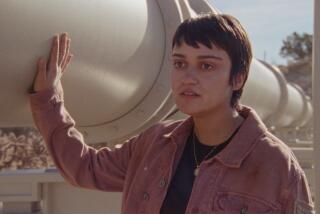Hollywood’s ‘Sonic the Hedgehog’ ignores one crucial element from the game
Never mind the teeth, “Sonic the Hedgehog” was one of the first major video games with an environmentalist narrative. Here’s what the filmmakers missed.
There’s a scene in “Sonic the Hedgehog” in which the blue hero rushes to the Pacific Ocean and returns in an instant, bringing with him pollutants and a flopping fish. The fish is left on the beach by Sonic, presumably to die, this despite the hyper-fast creature having the ability to return it to water in the blink of an eye.
The moment makes it clear that “Sonic the Hedgehog” the film isn’t particularly interested in the themes of “Sonic the Hedgehog” the game.
Adapting “Sonic the Hedgehog,” of course, was no easy task. The character, like Nintendo’s Mario or Disney’s Mickey Mouse, exists today primarily as a malleable brand icon, a blue-furred creature who serves the product that’s needed. What’s more, even the core “Sonic” games lacked linear narratives in the traditional sense, thriving primarily as colorful vistas and environments for exploration and challenges.
And yet there was clear hunger for the “Sonic the Hedgehog” film — it finished the holiday weekend with an opening box office tally of around $70 million. Although a trail of failed video game adaptations preceded it (last year’s “Pokémon Detective Pikachu” notwithstanding), “Sonic” has thus far proved to be the rare exception when it comes to melding games with cinema; here is a character we apparently want to watch as well as interact with.
But the success of the “Sonic the Hedgehog” film with audiences — the critical consensus is lukewarm at best — came at a cost: The film pivots from some of the core tenets of the “Sonic” brand, at least as they were originally envisioned. The “Sonic” film, directed by Jeff Fowler, has more in common with familiar cinema narratives — ones in which a friendly otherworldly creature is misunderstood and hunted — than it does the 2-D platformer games that made the character famous, which stands today as one of the first major video games to emphasize a pro-environment narrative.
Sonic is essentially fighting deforestation.
If there’s a mistake made by the “Sonic the Hedgehog” film, it’s this: The original games are smarter than the film appears to think they are.
In the film, Sonic is portrayed as an alien (voiced by Ben Schwartz) who befriends a small-town cop (James Marsden) and must evade the mad genius Dr. Robotnik, played by a mustache-twirling Jim Carrey. Only in the movie’s opening scene do we see the world in which Sonic was born, a bright and inviting universe boasting an abundance of wildlife and greenery. Occasionally we glimpse a dank and beige mushroom kingdom — a not-so-subtle jab at the main world at the heart of Nintendo’s “Super Mario Bros.” franchise — but the bulk of the film replaces the forestry of “Sonic” for small-town Americana.
Sonic’s home here is a cave that looks and feels like every child’s clubhouse dream, overrun with comic books and fitted with a beanbag chair. Although Sonic possesses superhero-like speed that’s essentially capable of stopping time, the frenetic action of the games is replaced with the speed limits of American highways, as a significant chunk of “Sonic the Hedgehog” settles into a road trip movie. Gone, thankfully, are the days when video game cinema meant nonstop cuts and obscene angles. The charms present in Fowler’s film focus on getting to know Sonic.
But this is a different Sonic than the one introduced in a 1991 video game for Sega’s Genesis console.
The Sonic of Hollywood is adrift and lonely, his power fueled by the bonds of friendship. The Sonic of the game is on a mission to reclaim the world from Dr. Robotnik, who is stripping the land of its resources and causing animal extinction by ensnaring it in machinery. It may not have been video game activism, but at a time when parents feared children becoming zombies who sat in front of a video game box, “Sonic the Hedgehog” showed the outside world as one of wonder, and one increasingly unrecognizable in the face of suburban and urban development.
Oscar’s big winner, ‘Parasite,’ and war tale ‘1917’ show how interactive entertainment is shaping linear storytelling — often for the better.
There are perhaps more complications to the “Sonic” lore that have been explored over the decades in multiple forms of media, but none is really present from revisiting the game that started it all. Sonic runs and rolls and jumps, freeing animals along the way and ridding his home world of an overabundance of items built by humans. While some of these themes may have been over the head of a younger me, it’s a clear environmental statement, a celebration of nature and the animal kingdom. Sonic, with every jump into an animal-turned-robot and attack on the evil scientist antagonist, is essentially fighting deforestation.
Every time Sonic smashes into a gross, intrusive metal contraption and destroys it, an adorable bunny or other forest critter is set free. The ugly vehicles of Dr. Robotnik even appear powered by cutesy animals, a clear indication that the antagonist’s quest for power comes at the expense of life, nature and the environment. Power-ups are hidden inside TV monitors, which Sonic blissfully destroys, and waterways in the game are littered with obscene machinery. Sonic in the film is bummed no one will play baseball with him; Sonic in the game is out to restore the natural harmony of a planet.
Early Genesis games were adept at slyly reaching for more ambitious ideas than they let on. “Ecco the Dolphin,” for instance, championed marine life and oceanic preservation, and “ToeJam & Earl” brought hip-hop and cultural diversity to the home video game console space. While narratives in all, including the environmental themes of “Sonic the Hedgehog,” are relatively abstract and exist more for those willing to put in the work to discover them, they show that so-called playthings have long been texts with depth.
Yuji Naka, one of the primary architects of “Sonic the Hedgehog,” in a 2010 interview describes the title as possessing “one of the first ecological messages in a video game.” It’s more hidden than blunt, and like the best of interactive media, its themes are visible when one takes the time to explore the environment, to notice that a robotic crab is wandering where baby birds once nested and nearly everything that stands in Sonic’s way is man-made.
As Naka said: “Dr Robotnik is a slightly radical representation of all humanity and the impact humanity is having on nature. In 1991, it was a very sensitive subject to talk about the environment and while I had my viewpoint, I did not speak of it. With ‘Sonic,’ I was given an opportunity to express my views in a different way and did so, showing Robotnik using pollution and creating machinery which desecrates the environment and it is down to Sonic to change his ways.”
The film, sadly, lacks those ambitions. Its only real pro-nature stance comes from having Tika Sumpter’s character Maddie work as a veterinarian. It’s a human world, and animals simply exist in it, albeit with our help.
In crafting a tale of Sonic versus Robotnik, the film’s underlying messages stray from anything that could be considered topical and, in turn, perhaps anything that could be considered controversial. There’s value, of course, in the film’s topics of selfless friendship, but if “Sonic the Hedgehog” the game was a love letter to nature, “Sonic the Hedgehog” the film plays it safe.
Sonic, of course, is still blissfully fast and owns a too-cool-for-school look. But the moment Sonic lets a fish flop to its death, what the film has run furthest from was the game’s original message.
The Player
More video game and immersive entertainment coverage from critic Todd Martens
More to Read
The biggest entertainment stories
Get our big stories about Hollywood, film, television, music, arts, culture and more right in your inbox as soon as they publish.
You may occasionally receive promotional content from the Los Angeles Times.











